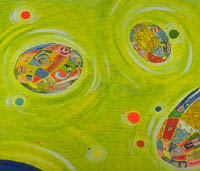
The little red riding hood, acrilic and pencil on paper, 2003, 14 x 20,5 cm
|
Bd Barthélemy 20, Brussels
Le petit chaperon rouge
|
Archétype Galerie
|
trhoughout March 13th, 2004
|
http://www.archtype.be
|
|
Inspired by the drawings of Isabel Baraona, Archétype presented a show based on Perrault·s story “Little Red Riding Hood”, a children·s story full of symbols and open to all kinds of interpretations. In her drawings, Isabel Baraona untiringly reinvented the woods where children and wolves endure the violence of adults. Little Red Riding Hood embodies our fundamental anguishes that are present in all the possible relationships in the story. Lucile Bertrand, researched the multiple versions of the story producing a series of book-objects about a humorous and poetic world. The Martin sisters made a mural on the walls of the gallery and presented a printed image of their video “C´est comme être”, in which they summarized the topic of the exhibition. Harald Thys and Jos de Grytes projected a strange video titled “The 48 hours of Kwik and Kwak” in reference to a previous experiment where two animals were filmed while eating, sleeping and playing for two days in a closed room. This piece also included text and photographs.
|
|

A perpétuité, neón yand video, 2000.
|
Rue Isidore Verheyden 2, Brussels
Marie-José Burki
|
Galerie Baronian – Francey
|
Trhoughout March 20th, 2004
|
http://www.baronianfrancey.com
|
|
The Baronian – Francey gallery exhibited video installations by Marie – José Burki, Swiss artist born in 1961 and a current resident of Brussels. Burki developed a videographic piece capturing our natural or urban environment with complete simplicity. Her projections are often combined with fragments of classical and prosaic texts where the camera gives the impression it is a passive spectator of the world around it: men and women at their jobs, the impenetrable universe of animal behavior, clouds drifting in the sky as metaphors of time undergoing perpetual transformations. Her work, although apparently anchored in reality, attempts to exalt and idealize this reality through video or translating it into linguistic symbols, thus establishing a cross between philosophy, poetry and politics. In Burki·s work it is possible to perceive a certain influence of Barnett Newman·s videographic work and Joseph Kosuth·s linguistic Conceptualism, which entirely eliminated the object to focus on the pure idea.
|
|

Rumori di vita, 1994, 150 x 150 cm
|
Bd. Saint Michel 35, Bruselas
Laboratory / Enrico Tommaso de Paris
|
Galerie Artiscope
|
Trhoughout February 14th, 2004
|
http://www.artiscope.be
|
|
Enrico T. De Paris was born in Mel (Belluno) in 1960. He currently lives and works in Turin. The interactive installation Laboratory that Artiscope presented from last November to February, is an ironic and original incursion into contemporary life that develops through a complex integration of different systems. The static chemical structures, videos, lights, digital images, books, paintings, sounds and disparate objects in addition to other elements, make up an imaginary file of new realities, such as bio-technologies, social migrations and new digital technologies. There are evident similarities between Tommaso de Paris· work and what is known in Argentina as the Madi movement, founded in the ·40s, especially regarding the relationship between art and science, the use of light structures with neon gas and, in general, the inclusion of new materials. In the ·60s and ·70s this idea was revisited by Argentine Luis Benedit with his concept of systems, in which living beings are subjected to observation in laboratories with a research method that is more scientific rather than purely artistic. In T. de Paris· work the relationship between art and science is apparent as in Benedit and the playfulness of the Madi.
|
|

